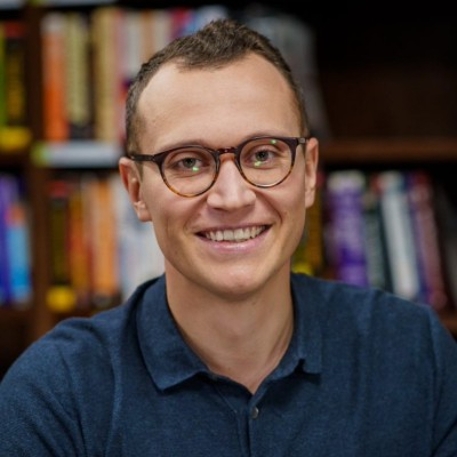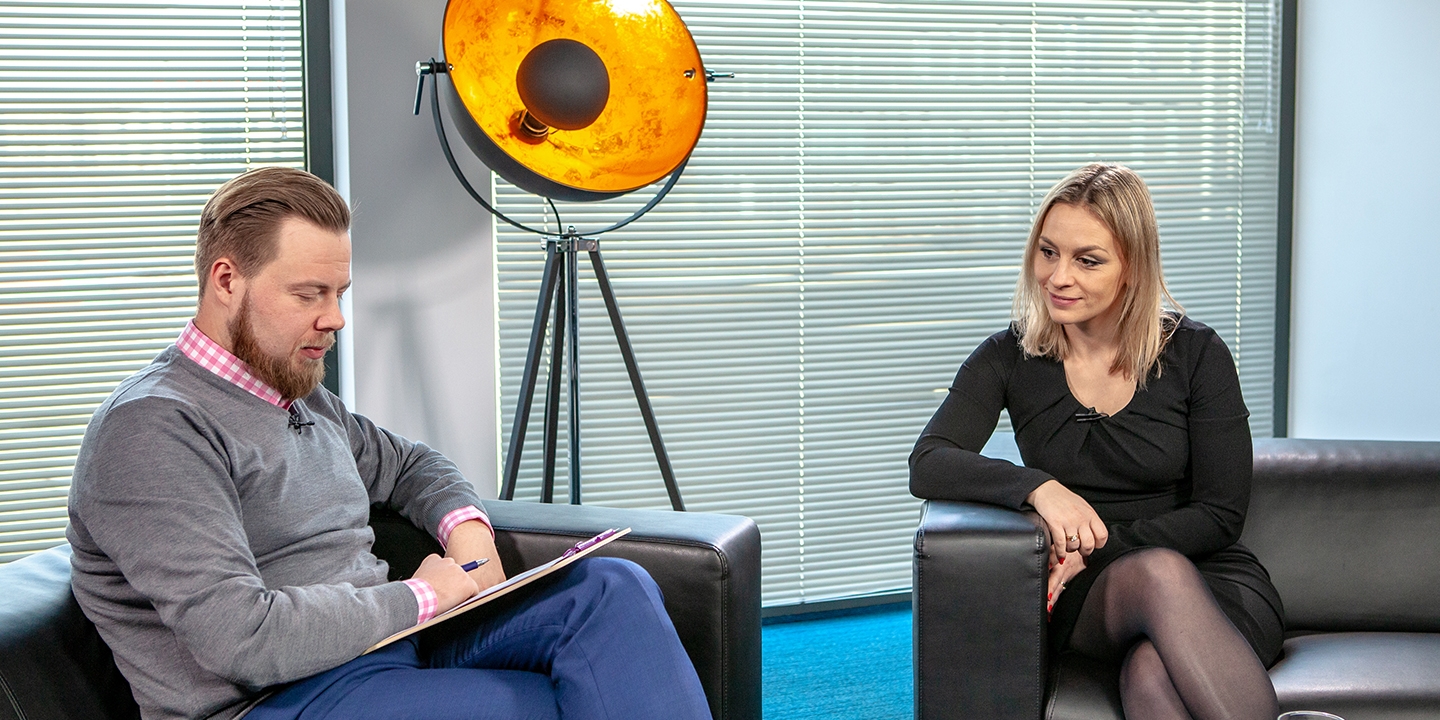- Insights hub
- /
- Evolution of financial in...

Evolution of financial inclusion and financial literacy with Nina Mohanty
- DetailsAbout the talks
- TranscriptTranscript
- Resources3 Files
Evolution of financial inclusion and financial literacy with Nina Mohanty
Michał Grela
Relationship Manager at Future Processing
The rapid acceleration of fintech industry in the past years, especially caused by the pandemics, has influenced lives of many people worldwide – also when it comes to the financial aspects. But there are still areas where the levels of financial inclusion and financial literacy are low.
There’re several reasons why it is important to improve these levels since on the one hand, financial literacy and financial inclusion touch on the very basic, core needs of individuals, and on the other hand – it has a huge impact in the large scale, on economies of the countries and their growth.
Research by EY presented that financial inclusion could improve GDP by up to 14% in more rural, developing economies like India and 30% in frontier markets like Kenya. Such increase would make a huge difference in terms of the economic growth.
My guest is Nina Mohanty who is passionate about FinTech and how it can better financial inclusion and financial literacy.
Michał Grela (MG): Hello, and welcome to yet another episode of IT Insights by Future Processing. Today, the topic of the conversation is the evolution of financial inclusion and financial literacy. The topic of the rapid acceleration of the FinTech industry in recent years, especially caused by the pandemic, definitely influenced the lives of many people worldwide. And that also comes down to the financial aspects of their lives. But there are still areas where the level of financial inclusion and financial literacy are low, sadly. There’s a number of reasons why this topic is important and why it’s important to improve this level.
Since on the one hand, financial literacy and inclusion touch on the very basic core needs of individuals. And on the other hand, they have a huge aspect also in the large scale, on the economies of the countries and the growth in general. Different researchers present that financial inclusion could improve GDP by as many as 14% in more rural developing economies and even by 30% on frontier markets. So that increase definitely makes a huge difference in terms of economic growth in the large scale.
And today, the guest of our conversation is Nina Mohanty, who is definitely a right person to have a chat about financial inclusion and international literacy with. She describes herself as fiercely passionate about women’s empowerment and education, and she dedicates her free time to furthering these causes. So a very relevant guest of our conversation today. And Nina, could you please introduce yourself?
Nina Mohanty (NM): Yes. Thank you so much for having me on with you today. And it’s such a pleasure to speak to you. Yeah. As said, my name is Nina Mohanty. I’m the founder and CEO of Bloom Money, and we are a platform that provides familiar financial services to migrants in the UK. But prior to doing this, I’ve had kind of a, well, I personally call it my portfolio of roles in FinTech. Starting at the brilliant MasterCard and then having worked at the likes of Sterling Bank, as well as Bud, the open banking platform, and most recently Klarna. So I’m a wide range of kind of both B2B and B2C FinTech. And really the underlying story of my love story with FinTech starts at MasterCard, which was a very serendipitous time when everything was kind of coming to a head with UK consumer FinTech, and Monzo was Mondo at the time. And Revolut was on the MasterCard Start Path, which is MasterCard’s incubator. And Starling was still an alpha at the time, but it was super, super exciting for me as a Silicon Valley native who has moved abroad to see technology being applied to people’s everyday life and trying to better the health of their financial life as well. And this was a really impactful moment in my life, because it really made me realize that there’s so much potential for FinTech. And I think that is the underlying current of my career, is just greater inclusion, greater diversity, whether that is in the workplace itself or in building products for different people and serving different communities. So that is me in a nutshell, and I’m just so pleased to be here with you today.
MG: Wonderful. It’s a very inspiring path to follow. So I’m really looking forward to understanding your insights on the matter. But maybe first thing’s first. Because like with any other term, financial inclusion, of course, can be understood differently. And depending on the perspective, I am sure that our audience can understand it differently. Because for some, just access to an open bank account and being able to make transactions is, let’s say, enough to be called or be perceived financially included. But for others, it’s much more than only a bank account, and that covers a wide spectrum of financial services. So in your opinion, just to build the backbone of the conversation, what actually financial inclusion and literacy stand for and how broadly should we understood these concepts?
NM: Yeah, that’s a wonderful question and a great opportunity for all of us to be on the same page. Isn’t it? I think financial inclusion as a term is something that means different things to different people. And I will go ahead and start off the podcast by saying something quite controversial, in that I think in the past few years, the term financial inclusion has kind of become similar to back in the day when everyone wanted to be green or now, even, when people really want to be perceived as green and climate-friendly or organic. It’s kind of like that stamp of approval. And increasingly, I feel financial inclusion has been co-opted to be a PR exercise or something that sits under a company or a bank’s corporate social responsibility arm, and not actually the core product part of the organization, which is such a shame. So for me, I very much agree with the World Bank, and they define financial inclusion as meaning that individuals and businesses have access to useful and affordable financial products and services that meet their needs, which are delivered in a responsible and sustainable way. So this is really important. There are some keywords I wanted to pull out from that definition because, useful. Yep. For sure. We all know what it means to have a useful service or product. But affordable and also delivered in a responsible and sustainable way means that yes, while there is credit available, for example, all around in the UK, oftentimes that credit comes with extortionate prices. Right? And so that doesn’t necessarily mean that it’s sustainable for the customer when we look at kind of payday lenders or pawnbrokers, for example. I think that there is this fallacy, as well, that is worth mentioning.
We often think of financial inclusion as something that happens over there, in some other part of the world. Somewhere hotter climate-wise than here, perhaps, in the UK or in Europe. We think of the wonderful things that are being done in Sub-Saharan Africa with mobile money or microfinance in Southeast Asia, which are all brilliant things, of course. But I think oftentimes we forget that financial inclusion is also incredibly important here in our own backyards. So here in the UK, for example, it was estimated by the Financial Conduct Authority that one million people, one million adults, I should say, do not have access to a bank account. So it’s something that we need to be aware of here in our own countries, as well as abroad when we talk about our mission of financial inclusion.
MG: Yeah. I definitely agree, and I think that’s special. The context is important at the moment, with pandemic accelerating both growth and the way things move forward, as well as the differences that are now definitely sharper. And more and more often, the bridges that we have to build to bridge the gaps are now longer than before the pandemic. And I said in the intro of our conversation, this acceleration, of course, also hits in a positive way from time to time.
Only in Latin America, more than 40 million people have opened accounts since the second half of 2020, according to America’s market intelligence. Similarly in the Philippines, shortly after pandemic, four million digital bank accounts were opened. So that is huge acceleration, but of course that’s still not enough. From your perspective, what do you think? How can we achieve financial inclusion globally? And what’s FinTech’s role in achieving it?
NM: Yeah. So I think as you rightfully said, financial inclusion doesn’t just mean access to a bank account. I think that is a great first step, but we have to remember that financial services do not exist in a vacuum. Right? And so there is an entire ecosystem for you over in Poland. Unfortunately I’ve not had the pleasure of going to Poland quite yet. Once we’re able to, I’ll get on a flight and I’ll come visit you. But the situation or the context of living in Poland day-to-day might be very different than that in the UK, for example.
So having access to a bank account is wonderful, but oftentimes we forget about things along the way that make it difficult for people to access a bank account. And so we find issues with people needing an actual address, for example. Right? So as part of just the onboarding flow, while you can have a digital bank account, oftentimes in the Western world, at least, you are going to need to go through something that may be on FIDO. ComplyAdvantage have done a great job of making this onboarding much more digital. But if you, for whatever reason, have ended up in a situation where you no longer have an address, so perhaps you are in a vulnerable situation and find yourself homeless. Perhaps you’re a survivor of domestic abuse and you need to leave your home, and now you don’t have a permanent address. How are you supposed to access financial services or open a new account? So there are some really great companies. One I think of is ProxyAddress, based here in the UK. It was founded by an architect named Chris who is a wonderful man, who basically said, “Well, there’s all these kind of empty buildings in the UK. And there’s a lot of people that need just a permanent address. And how can we work with financial institutions to provide them almost a virtual address?” And this is something that, as a business owner for Bloom, we also have a virtual address.
So why can’t a person have one? And so we see innovation in that regard. In the actual onboarding, for example, another thing that really hinders financial inclusion is identity. Right? So if you don’t actually have access to an identity document, for whatever reason. For example, say you are a refugee and you have had to flee your home with no warning. It might not be on the top of your mind when you’re fleeing to grab your passport or your identification document or something. And so it can make for quite a bit of trouble to try and identify yourself when you get to the next place or port of entry, wherever you’re going. And that obviously makes it difficult to open a bank account. So there’s a lot of companies that are looking at digital identity. And a lot of our colleagues over in the blockchain space, I should probably have a better name for it, are looking at kind of distributed approaches to identity. That is brilliant. But then there’s also other things, as well. Well I should say that there’s things like digitizing benefits, for example. Right? So oftentimes things that are a part of the social net of a country, like social benefits, can be quite clunky and difficult to access. And while we can argue about whether that’s a purposeful dark pattern and making it as difficult as possible for people to access social benefits. That might be the case, but it also, in times like coronavirus, makes it really, really difficult for people to go in and actually put food on their table. Right? If they can’t access their benefits in a safe and secure way, digitally. So there’s lots of other avenues beyond just the actual financial services part. But if we want to talk about the actual financial services part, yes, great. Let’s give someone a bank account. Wonderful. What are the next steps after that? So at Bloom, for example, we’re looking at access to credit and financial literacy more broadly in terms of saving. And what we find with our community, which is largely made up of migrants and refugees, is that these people are coming from places where the idea of a credit score is completely foreign. Pun intended here. Where your ability to get credit in, I don’t know, one market in rural India, for example, where my grandmother is, is not by having an Experian or an Equifax credit score. But it’s simply by who you know and who you see at the temple and who you see at the market. Right? And having a positive relationship with them. And that is your ability to get credit. It’s very community driven. It’s very people driven. And so what we’re betting on is that people like migrants and refugees here in this country are actually probably more credit-worthy than we give them credit for. Again, pun intended. And so we’re looking at alternative ways to underwrite them and make sure that if we do choose to lend out money, eventually, are we going to get it back? And how short can we be of that? And what are alternative models that we can use to approach that question? So I could wax lyrical about this for hours and hours, but I think that gives you a quick overview of how we think about financial inclusion more broadly.
MG: Yeah, it really does. Thank you. You covered so many important aspects, and that was a really eye-opening part where, as said, for many, just having a bank account is enough. But as you said, there’s so many aspects apart or on that way or after that point, where the people tend to not take into consideration that they’re also crucial when it comes to the very important aspects of human life, such as credit or social benefits or being able to access money or identify yourself. Which, of course, might be a struggle. And you very briefly touched on the aspect that I wanted to talk about next, meaning how can technology help in this situation? You mentioned blockchain. You said that that might be a way. But there’s of course aspects that require immediate improvement, and perhaps technology here could be a leverage.
NM: Mm-hmm (affirmative). Absolutely. In terms of actually getting people to access these sorts of things, perhaps I can ask you to rephrase the question. Right, right, right. Sorry. So I think a big part of this is a lot of people think that there’s like a silver bullet. That if we make everything digital, it will be great. And don’t get me wrong. This is a great thing to be able to do and to make things digital. A big part of this, as I mentioned with benefits, for example, it can be really difficult and clunky to try and get benefits that aren’t digitized. Or even wages are often paid in cash around the world. So how can we move to a different approach? And I think that what we see is not necessarily next generation technology, but it’s applying technology to existing solutions. So what is super interesting to me is like, in Sub-Saharan Africa, we see that agency banking or agent banking, I should say, is really popular. Where you’ve got one person that’s designated as an agent, and that person goes into a village, and everyone’s able to do their banking and that sort of thing. And if we think about historically, this is something that people have been doing for probably hundreds of years, where someone came around and collected money, or people were able to withdraw from a person that came into the village once every month or something like that. And so, what we’ve now done is moved things into a digital fashion. And so that person now comes equipped with an iPad or a tablet of some sort, and they’re able to do things for people like that and send money digitally or move money around.
I think the other interesting thing is I’m really fascinated with biometrics right now. So both for identity, that problem that I pointed to earlier. But I know with these agent banking kind of solutions, for example, I can’t remember where I heard this. But someone was saying that there was quite a bit of fraud that started going on, where you would have someone who was dead collecting payments of some sort. And what had happened was that someone, I mean, rather gruesomely borrowed their thumb. Right? And took it to go collect some money with a thumbprint, but then they realized that this was happening.
MG: Oh boy.
NM: And they thought, okay, we need it to be a warm thumb. Right? Like a proper alive human being’s.
MG: Or they’re still breathing.
NM: I know, right? It is quite astounding. But similarly to how if you own an iPhone or actually even an Android, you need a little bit of warmth. Oftentimes, if you try to use your touch ID, you’ll notice that it doesn’t quite work if you’re in a really, really cold place, for example. You need that almost proof of life. That needs to happen, as well. So what we’re seeing is just the application of technology to existing solutions, which is super interesting. What we’re doing at Bloom is we’re digitizing something called a ROSCA, a rotating savings and credit association. It’s a method of borrowing and saving that’s been done around the world, especially in the Global South for, I would say, at least many, many decades, if not hundreds of years. And it’s a community driven approach to financial services. But what we’re doing is allowing people to use our platform and technology to actually do these things, again in a safe and secure way that mitigates fraud, that mitigates someone taking actual cash and collecting it in one place altogether. And so, as I said, I think there’s a lot of opportunities to kind of add a scalable technology, as well, to existing solutions.
MG: And I liked the bit you mentioned, that there’s no need to reinvent the wheel. It’s just using existing technology as a leverage. That’s the way to go. I really like that one. Let’s move the conversation towards another stream. Women empowerment is one of your topics of interest as well.
NM: Yes.
MG: I can already tell that you’re happy with touching on that point. Because gender-specific data points out that servicing women provides the same, if not higher, usage rates than when servicing men. Women are more disciplined in payments, while the cost of onboarding them are lower. So I’d like to ask you about how would you describe the inclusion and literacy when it comes to finances and women. I know that there are more and more products or platforms designed mainly for women. Do you think that’s a trend to follow? How would you approach that one?
NM: Yeah. So I think we are at a crossroads right now, where we know that this past year with the pandemic has really been a tale of two cities. Where we have had a lot of people really just being asked by their government to please stay home, continue to work. And if you’re someone that sits behind a laptop each day, that’s great. And while unfortunately there were probably furloughs and laying offs here and there, a lot of people were quite privileged. But we also know that in the past year, well, 2021 will be the first increase in extreme poverty since 1998.
MG: Yeah, unfortunately.
NM: Unfortunately with a minimum of 71 million people expected to fall into destitution. So that also means that there will be 247 million girls and women that are living below the poverty line worldwide. And we kind of have to approach it from two different ways, right? Because there is also what a lot of people have referring to as the women’s recession, in the Western world, where we found that women, especially caretakers, whether of young children, of older adults, were really being penalized and oftentimes had to drop back to part-time roles or just leave their jobs entirely so that they could make sure that their children were going to school. So that they could care for their elderly parents or parents in-law. And so, it’s been a tough year to be a woman, for sure. I think, recently there’s been a whole host of businesses that have sprung up that are very much focused on financial literacy and financial empowerment for women in the Western world. So the one that really jumps to mind immediately is Ellevest, which was founded by Sallie Krawcheck in the US. The idea being that women do have so much purchasing power, and yet we don’t really invest it, because there’s that stereotypical idea that women are more risk averse. But actually, when you put a woman and a man, I think there was a study done by Warwick University where they found that actually women, longer-term, outperformed male portfolios when investing. And so, we know that women may tend to be more risk averse, but women also, for example, invest longer-term. But we also know that there are things like the wage gap and the pension gap, and there’s a lot of gaps that need to be filled. And so a lot of that is outside the bounds of necessarily financial services industry. A lot of that has to do with just the very makeup of society, where a lot of us have to negotiate harder for that pay rise, or we need to have a partner that is going to be equal caretaker to children, who is going to step back as well or allow us to continue working after maybe having a child or needing to take time off for care-taking roles. So there’s a lot of things going on, but I think the positives is we know that when women do invest, they tend to outperform male portfolios, for example.
We know that in the developing world, I don’t really like that term, honestly. But let’s call it the Global South, where we see a lot of microfinance projects. We see companies like Grameen Bank in Bangladesh that does micro-financing to women in a village, or companies like Tala, based in Santa Monica in California, that does microfinance in developing countries. That when they do microfinance lending to women, they tend to have really great results. And last I checked, from Grameen Bank and Grameen America, they are boasting repayment rates of like 99%. Which Barclays Bank or Lloyds Bank can only dream of, right?
So investing in women is such a wonderful and necessary thing to do. I think this, though, ties back to the idea of when we talk about financial literacy, I find it quite funny actually. Because the answer is very much in the phrase itself, isn’t it?
MG: It is, yes.
NM: So financial literacy is very much based on literacy. Right? And so the literacy rate.
MG: How simple was that?
NM: Yeah. I mean, to give you a solid definition, the literacy rate measures the percentage of adults in a country who are able to read and write in their common language. Well, you know what? When I think about my grandmother who was born in a village and was taken out of school. And so, she is a very, very, very astute woman. I respect her immensely. And yet, I wouldn’t necessarily say that she’s the most literate woman in the world. Right? And so around the world, a big part of financial literacy is actual literacy, as well, and women’s education. So if we want to talk about financial inclusion for women, that goes hand in hand with education. And unfortunately, we’ve seen a lot of countries like the UK, for example, recall a lot of their budgets that are going towards women’s education worldwide after this past year, as national budgets are shrinking and that sort of thing. But I think if we want to move into a more prosperous future where women can benefit as well from a global economy, then that means we also have to invest in just basic education, as well. I think the other thing is, I don’t know. I’m Asian, so my father’s Indian, my mother’s Taiwanese. And in our culture, it’s really taboo to speak about money. I don’t know about you. Is it the same thing in Poland, where it’s just like you don’t really talk about money ever?
MG: Yes and no. I mean, maybe my parents would feel slightly uncomfortable sharing their wage with their peers. But people my age, that’s completely normal.
NM: Yeah. So maybe it’s being more normalized now, and that’s wonderful to hear. But I know with my girlfriends, if you ask someone, I’m pretty forthcoming about how much I’m earning if a friend asks. Although I’m a startup founder now, so I’m not earning that much anymore. But before, it used to be, I would be very forthcoming. I’d ask, “How much are you able to save?” And it can be very uncomfortable, because from such a young age, we are taught not to talk about money. It’s rude. It’s impolite to speak about money. And I think that, in a way, has really set us back because we can’t get together and kind of go, “Oh. Yeah, I’m going for this role. Do you think I should ask for X amount?” Instead, we just keep it very hush hush, and we don’t talk about it at all. So something that I encourage women to do is like, just talk about it. It can be super uncomfortable, and it can also be a bit of a slap in the face sometimes when you realize like, oh. I’m actually not earning as much as my peers. But that also is a good wake-up call where you can go, all right. What is happening? I’m not earning as much as my peers. Is it something that I need to look within and improve my performance? Is it that I’m working in an industry where this is normal, and can I benchmark it against other industry salaries, for example? Or is it that I’m being underpaid? And quite frankly, I just need to ask for more. And then from there, who can I speak to, to ask for more? And how can I practice negotiating that? So there are so many things. Again, this is another topic of mine that I really love to talk about.
MG: I assumed that.
NM: But I think that women, well, women are the future for sure. But I also think that women’s, I guess they’re always referred to as women’s projects or whatever, are always the first in the budget to be slashed. And so I think we really need to double down on that. And then lastly, I very much encourage anyone who listens to this in their workplace. If you’re collecting data of any sort that has to do with customers, I very much encourage you to sex disaggregate your data. Because that will start to paint a very, very interesting picture. I got this term sex disaggregate from the author Caroline Criado-Perez, who wrote the book Invisible Women, which is a book I recommend to everyone. But this idea that oftentimes women are lumped together with men, as the male being the default. Right? So it’s called the male default. And so this can have disastrous effects, not just in financial services where we have a wage gap, we have a pension gap. We also take time out. We live longer. All of these different kind of factors that affect a woman’s life. But also in health, where they recently found out that up until recently, blood pressure for men, the default that we’ve been using, is actually much, much higher than it is for women. And oftentimes, I think it’s like a woman’s ideal blood pressure rate should be 120 over 80, which is much less than a default male. And so, if a woman is up to a male’s rate, often that actually might mean she’s in risk. So that’s literally a life or death kind of situation. And so this is something that we need to take into account when we’re gathering data. If we want to make things better, we need to record it so that we can change it.
MG: I don’t think there’s much I can add to that one. Last but not least, from your perspective. And if you would have a magic wand, what would be the ideal world scenario when it comes to financial literacy inclusion that we, meaning societies, businesses, FinTech ecosystem members in general, should aim on reaching?
NM: Oh goodness. That is such a difficult one. You know, I think the ideal world scenario, I mean in a perfect world, we’re all holding hands and singing kumbaya and there’s no coronavirus and we can all see each other. But I think what we really need to focus on as a first step is actually digital inclusion. And this is something, when we talk about financial inclusion and I talked about all of these technological advances and how we’re applying that to existing solutions, right? But that is all well and good until you realize that a lot of people are missing out on a lot of the financial inclusion campaigns or projects because they don’t have digital inclusion. So in the UK, there are 11.7 million people who lack basic digital skills. And there’s 1.9 million households without internet access. This is in the UK, right? So we’re not even talking about Myanmar or something, in a rural village somewhere in Myanmar. We’re talking about in this country, in the United Kingdom. And I don’t unfortunately have the stats at hand for Poland, but the digital divide is definitely most prominent for people living in poverty who also lack digital skills. And not just that, but think about this past year with a lot of our elderly having to shield or quarantine themselves away from their children and their grandchildren. Well, oftentimes this leaves them in a very vulnerable situation because now they can’t get groceries. They are used to going to the bank and chatting with the teller and getting cash out and then going to the grocery store. But now they can’t do that. Right? So I think a great first step is to really focus on digital inclusion as a first step.
There’s a really great program called Nobody in the Dark that’s in the UK, and there’s also another organization called DevicesDotNow. But I think worldwide, this is something that we need to be cognizant of. And you cited some really great statistics about the number of bank accounts that were opened in the Philippines, in Latin America. But that is in large part due to the fact that people had access to smartphones. Right? Had access to the internet and therefore were able to open these accounts in a digitally friendly way. So that’s the one thing I would wish for if I came across a genie. And then of course, it goes without saying to double down on women. Always invest in women, because you can’t go wrong in that regard. And feel free to invest in me as well, because we are fundraising.
MG: Exactly. Blue money. Link in the description. Thanks, Nina. I really enjoyed other one. To be honest, at least initially, my goal was to have more of a conversation rather than an interview. But you were so fiercely passionate about your ideas that I felt like the best I can do is just let you speak. I’m sure it ended up a very, very inspiring conversation. Thank you, Nina. Great having you.
NM: Thank you so much. It was such a pleasure. And next time, we’ll do it in person, and it will be a proper conversation. I’m sorry.
MG: No.
NM: I have so much to say. So next time, we’ll do it in Poland. Yeah?
MG: I’m happy that you said you’d go. Thank you, Nina. Bye.
NM: Amazing. Bye.
INSIGHTS
Check similar insights
Contact
Get in touch
Have any question about specific material?
Let us know!










